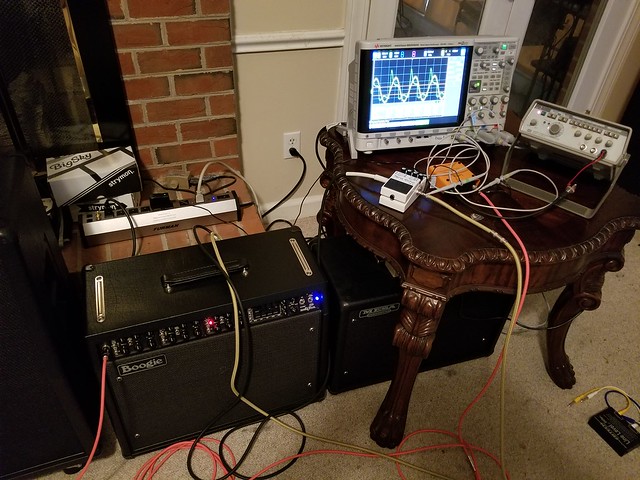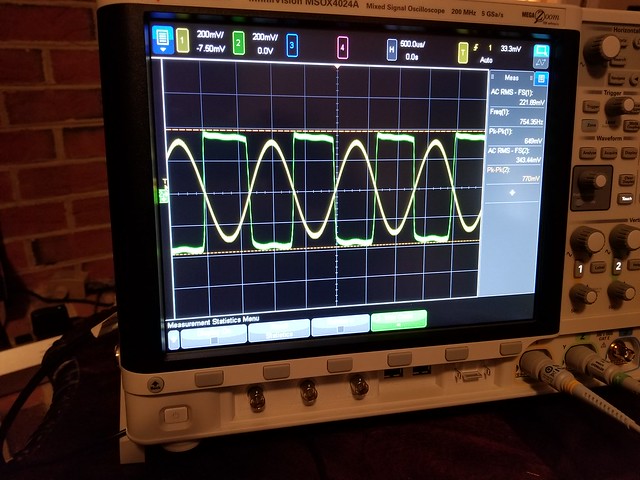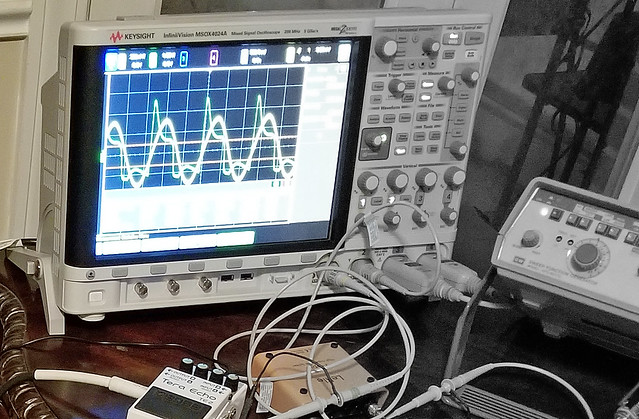This is interesting but the test was actually annoying but I was able to set the global master to null to keep the single frequency from drilling into my head.
I had borrowed the better oscilloscope from work, a function generator and a few of the probes but did not need to use them. However the setup was quite easy, find two cables that did not have heat shrink on the soldered coax cable joints. For this test, I did use the Lehle P-Split 2 to provide isolation from the function generator and the Mark V amp. I dialed in a 640mV p-p signal fixed at 750Hz. The voltage was set to the average voltage measured with the guitar as the signal source (excluding the initial attack impulse). Since it is easier to convert from RMS to dbu and dbv units I set the scope up to display the rms voltage of the signal, the same was used at the FX Send. I also used a Boss Terra Echo in hard bypass mode in the FX loop and measured the send level at the input of the pedal. For each channel, I disabled the EQ function for the initial pass as that greatly influenced the signal level on the FX loop as well as added some distortion so I figured it best to leave it off and then followed through with the 5BEQ turned on in a V shape pattern, 750Hz slider was at center as this was the test frequency. The preset basically reduced the test frequency dramatically so it was not included. All three channels had the control settings set to noon. as for the mini toggle for each channel, Bold, Mark I thick (only effects mark I voice) and bright were set. Also the FX send level was at noon. Keep in mind that the measurements were done with a single frequency and will be much different with the guitar driving the amp. So use the measurements as a reference. Also note that the Master volume had no influence on the FX send level.
The empirical data is as follows:
Input voltage: 217.17mV rms fixed at 750Hz: 217mVrms = -11dBu
CHANNEL 1 influence on the FX loop
(5BEQ turned off)
Channel 1 - Clean: 2.70 dBu
Channel 1 - Fat: 1.36 dBu
Channel 1 - tweed: 5.82 dBu
(5BEQ turned on, V shape but with 750 at center)
Channel 1 - Clean: 4.50 dBu
Channel 1 - Fat: 4.11 dBu
Channel 1 - tweed: 4.27 dBu
CHANNEL 2 influence on the FX loop
(5BEQ turned off)
Channel 2 - Edge: -1.96 dBu
Channel 2 - Crunch: 1.88 dBu
Channel 2 - Mark I: -2.95 dBu
(5BEQ turned on, V shape but with 750 at center)
Channel 2 - Edge: 1.99 dBu
Channel 2 - Crunch: 4.10 dBu
Channel 2 - Mark I: 2.06 dBu
CHANNEL 3 influence on the FX loop
(5BEQ turned off)
Channel 3 - IC+: 3.722 dBu
Channel 3 - MKV: 3.50 dBu
Channel 3 - Extreme: 3.80 dBu
(5BEQ turned on, V shape but with 750 at center)
Channel 3 - IC+: 5.79 dBu
Channel 3 - MKV: 5.80 dBu
Channel 3 - Extreme: 5.81 dBu
 [/url]
[/url]
I had borrowed the better oscilloscope from work, a function generator and a few of the probes but did not need to use them. However the setup was quite easy, find two cables that did not have heat shrink on the soldered coax cable joints. For this test, I did use the Lehle P-Split 2 to provide isolation from the function generator and the Mark V amp. I dialed in a 640mV p-p signal fixed at 750Hz. The voltage was set to the average voltage measured with the guitar as the signal source (excluding the initial attack impulse). Since it is easier to convert from RMS to dbu and dbv units I set the scope up to display the rms voltage of the signal, the same was used at the FX Send. I also used a Boss Terra Echo in hard bypass mode in the FX loop and measured the send level at the input of the pedal. For each channel, I disabled the EQ function for the initial pass as that greatly influenced the signal level on the FX loop as well as added some distortion so I figured it best to leave it off and then followed through with the 5BEQ turned on in a V shape pattern, 750Hz slider was at center as this was the test frequency. The preset basically reduced the test frequency dramatically so it was not included. All three channels had the control settings set to noon. as for the mini toggle for each channel, Bold, Mark I thick (only effects mark I voice) and bright were set. Also the FX send level was at noon. Keep in mind that the measurements were done with a single frequency and will be much different with the guitar driving the amp. So use the measurements as a reference. Also note that the Master volume had no influence on the FX send level.
The empirical data is as follows:
Input voltage: 217.17mV rms fixed at 750Hz: 217mVrms = -11dBu
CHANNEL 1 influence on the FX loop
(5BEQ turned off)
Channel 1 - Clean: 2.70 dBu
Channel 1 - Fat: 1.36 dBu
Channel 1 - tweed: 5.82 dBu
(5BEQ turned on, V shape but with 750 at center)
Channel 1 - Clean: 4.50 dBu
Channel 1 - Fat: 4.11 dBu
Channel 1 - tweed: 4.27 dBu
CHANNEL 2 influence on the FX loop
(5BEQ turned off)
Channel 2 - Edge: -1.96 dBu
Channel 2 - Crunch: 1.88 dBu
Channel 2 - Mark I: -2.95 dBu
(5BEQ turned on, V shape but with 750 at center)
Channel 2 - Edge: 1.99 dBu
Channel 2 - Crunch: 4.10 dBu
Channel 2 - Mark I: 2.06 dBu
CHANNEL 3 influence on the FX loop
(5BEQ turned off)
Channel 3 - IC+: 3.722 dBu
Channel 3 - MKV: 3.50 dBu
Channel 3 - Extreme: 3.80 dBu
(5BEQ turned on, V shape but with 750 at center)
Channel 3 - IC+: 5.79 dBu
Channel 3 - MKV: 5.80 dBu
Channel 3 - Extreme: 5.81 dBu
























